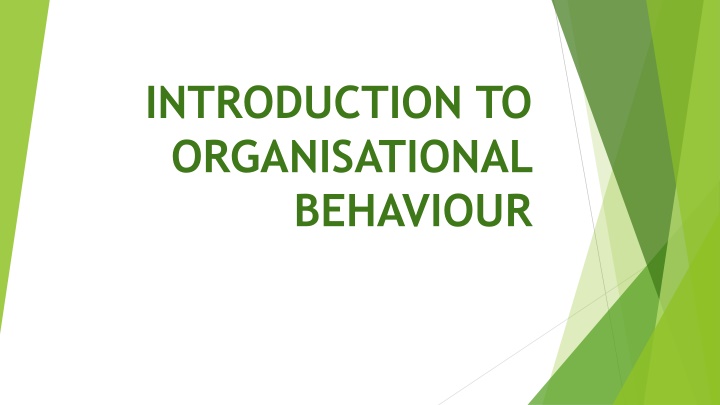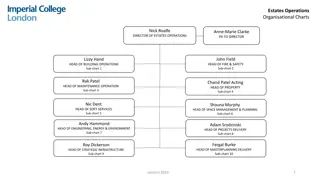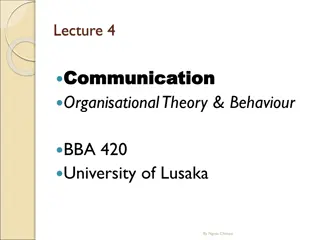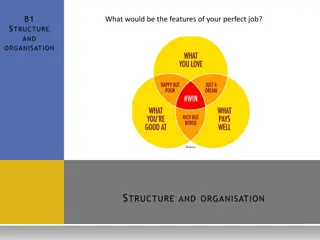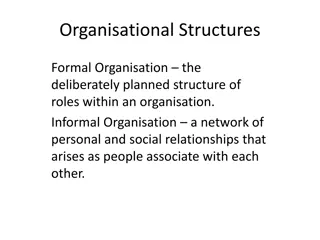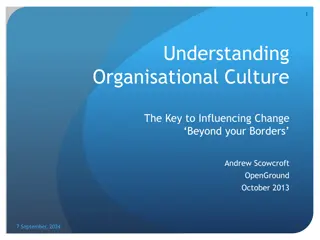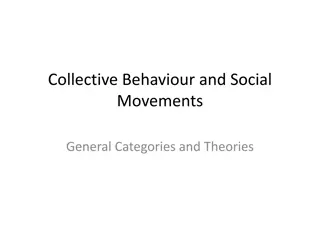Overview of Organisational Behaviour: Evolution and Impact
Organisational behaviour entails the study of human behavior within an organization, exploring individual and group dynamics, structure impact, and achieving organizational effectiveness. It traces back to the industrial revolution era with concepts like Scientific Management and Human Resources Movement. The recognition of the Human Factor stemmed from events like the Great Depression and experiments like the Hawthorne Studies, shaping how organizations view and interact with their workforce.
Download Presentation

Please find below an Image/Link to download the presentation.
The content on the website is provided AS IS for your information and personal use only. It may not be sold, licensed, or shared on other websites without obtaining consent from the author.If you encounter any issues during the download, it is possible that the publisher has removed the file from their server.
You are allowed to download the files provided on this website for personal or commercial use, subject to the condition that they are used lawfully. All files are the property of their respective owners.
The content on the website is provided AS IS for your information and personal use only. It may not be sold, licensed, or shared on other websites without obtaining consent from the author.
E N D
Presentation Transcript
INTRODUCTION TO ORGANISATIONAL BEHAVIOUR
Meaning And Definition of Organisational behaviour: Organisational behaviour is concerned with the study of human behaviour at work. It is a study of how people as individuals and as group behave or act in an organization. According to Stephen behaviour is a systematic study of the actions and attitudes that people exhibits within organisation . P Robins Organisational
Elements of Organisational Behaviour: It is an investigative study of individuals and group. Impact of organisational structure on human behaviour. Application of knowledge to achieve organisation effectiveness.
Historical Evaluation of organisational Behaviour: Formal study of organisation behaviour began in 1890 s following industrial revolution movement. In 1890 s F. W. Taylor identified the positive effect of precise instructions, goal setting motivation. These ideas became scientific management, considered as the beginning of the formal study of organisation behaviour. and reward or
Scientific Management: Scientific Management is based on the belief that productivity is maximized when organisations are rationalised with precise sets of instructions based on time and motion. F. W. Taylor is often called as Father of Scientific Management . Four principles of Scientific Management: 1. Studying task using time and motion study. 2. Scientifically select, train and develop workers. 3. Managers provide detailed instructions. 4. Divide work between workers and managers.
Human Resources Movement: Failure of Scientific Management gave birth to HR Movement. Characterised by heavy emphasis on workers co- operation and morale. People are treated as human beings and not machines, giving more importance to their needs and problems.
Three reasons contributed to the recognition of Human Factor in an organization are: Great Depression of 1929. Hawthorne Experiments. Labour Movements.
Great Depression: Crash of American Market lead to world wide depression, unemployment , collapse of economy. It was realised that production alone is not management function, but marketing ,finance and human resources are required for survival of business. Aftermath department and human relations got direct/indirect significance. human problems, role of personal
Labour Movement: Continuous exploitation made workers to realise their protections lies in their own hands. Formulated labour union that had desired effect on management. Working hours, conditions and Wage policies. Unions organisations. incorporated human relation in
Hawthorne Experiments/Effect: Series of experiments that came to be known as the Hawthorne studies western electric plant workers in Hawthorne. were conducted on This effect occurs when people improve same aspect of their behaviour or performance simply because they know that they are being assessed.
Hawthorne Experiments/Effect (cont) Research involved the following study Illumination Experiments (1924-27) Light decreased for experimental group and kept constant for other. Productivity increased in same rate. Workers work harder when watched.
Relay Assembly Test Room Experiments (1927-28): Workers segregated on the basis of a definite range of working condition variables such as work room temperature, work schedule, work break etc. Recorded the time taken by employees to collect telephone relay. Productivity increased Irrespective of how factors manipulated.
Experiments in Interviewing Workers 1928: Directly interviewed workers to find out what is important to them in their opinion. Workers were allowed to open up and talk freely about what is most important and what are at time problematic issues in their minds. Led relationship to the formal organisation. to the informal organisation and its Led to interpersonal dynamics of people at work. a rich understanding of the social,
Back Wiring Room Experiments: This experiment confirmed the power of the peer group and importance of group influence on workers behaviour and productivity. effect of the The productivity and vice versa. higher the norms, the greater the Conclusion: The history of organisation behavior begins with the work of F. W Taylor when he developed scientific management and encompasses the studies Hawthorne studies. with
